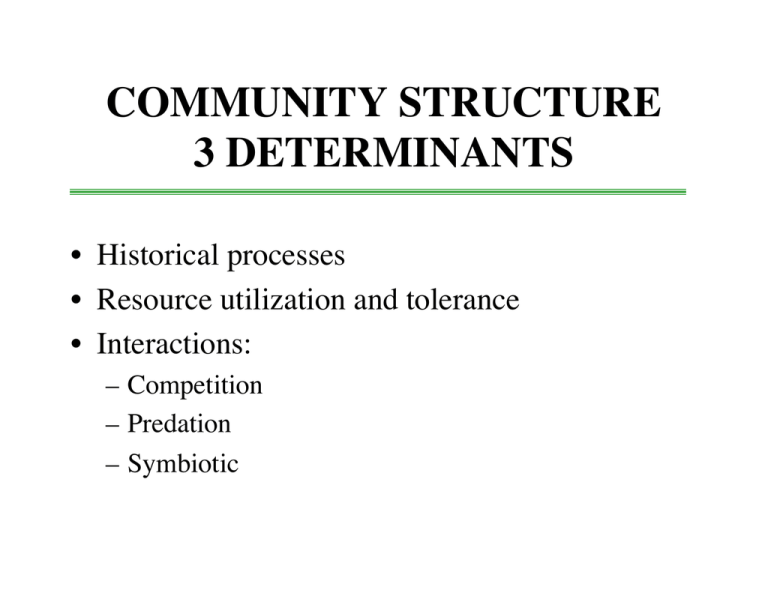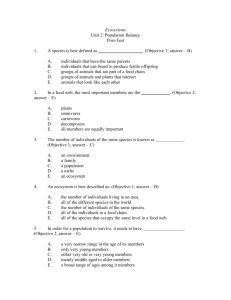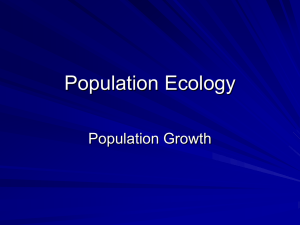
COMMUNITY STRUCTURE
3 DETERMINANTS
• Historical processes
• Resource utilization and tolerance
• Interactions:
– Competition
– Predation
– Symbiotic
SALINITY
RESOURCE UTILIZATION
AND TOLERANCE
MAX
MIN
NICHE
MIN
PARTICLE SIZE
MAX
A FACT
• Only rarely does the realized niche of an
organism approximate its
fundamental niche; usually it
is smaller
INTERACTIONS:I
• Interspecific competition
DARWIN’S VIEW
• “Owing to the high geometric rate of increase…as
favored forms increase in number so generally will
less favoured forms decrease and become rare…
between species when they come
into competition with one another”
from The Origin Of The Species,
1878
CONNELL’S BARNACLES
DEPTH
A L D
Balanus
C
A
L
D
Chthamalus C
FORMS OF COMPETITION
• Preemption
FORMS OF COMPETITION
• Overgrowth
FORMS OF COMPETITION
• Chemical interactions
FORMS OF COMPETITION
• Territorial
FORMS OF COMPETITION
• Encounter
INTERACTIONS:II
• Predation
A FACT
• Predators can have both direct and indirect
effects on prey.
• At the population level predators can have
density and/or trait mediated effects
DIRECT AND INDIRECT
EFFECTS OF PREDATORS
Density
mediated
Trait
mediated
DENSITY MEDIATED
EFFECTS
• Predators can directly effect prey population
size by removing (killing) prey
TRAIT MEDIATED
EFFECTS
• Predators can indirectly effect prey
population size by causing prey to alter their
behavior and thus affecting prey numbers
HOW TO TEST FOR TRAIT
MEDIATED EFFECT
• Place “predator” in habitat with prey but
prevent predator from eating prey
• Two options: (1) release predator cues (e.g.
odour) or (2) release non-predatory
predators (e.g. Glue mouth parts)
Normalized Plant Yield
CLASSIC EXPERIMENT
1.2
1
0.8
0.6
0.4
0.2
0
Plant Only
P + Herbivore
Treatment
P + H + Predator
ANOTHER FACT
• Predators have the potential to nullify or
reverse competitive processes
INTERACTIONS:III
• Symbiosis
3 TYPES OF SYMBIOTIC
INTERACTIONS
• Parasitism (+ -)
• Commensalism (+ 0)
• Mutualism (+ +)
POPULATION ECOLOGY
• This says it all
Nt+1 = Nt + B - D + I - E
Where: B= Birth, D = Death,I =Immigration, E
= Emigration
Nt
Time
TYPES OF LIFETABLES
• Diagrammatic
• Conventional
– Dynamic (Horizontal)
– Static (Vertical)
OAT
Mature
Individuals
10
15
Invasion
?
Seed Rain
150
.02
Seed Bank
0.3 +?
R1
R2
0.0
0.1
Seedlings
0.03 +1.6
0.6
Plants
0.02 +1
1.0
Mature
Individuals
1.02
OAK
Adults
4820
0.01
Seeds
48
0.06
Invasion
?
Seed Bank
3
1.0
0.08
Seedlings
0.26
R2
R1
0
PreAdult
0
?
Adults
0.01
CONVENTIONAL
SURVIVORSHIP CURVES
A SIMPLE IDEA
YEAR 1
YEAR 2
SOME TERMS
• Replacement rate • When:
R = 1, Population is stable Nt+1 = Nt
R < 1, Population is in decline Nt+1 < Nt
R < 1, Population is increasing Nt+1 > Nt
CONCEPTUAL MODEL
B-D+I-E = R
Nt+x = Nt * R
Intrinsic
Properties
EXPONENTIAL GROWTH
• N5 = N0 *R*R*R*R*R = N0 * R5
e.g. N0 = 2, R = 3, T = 5
N0 * R5 = 2 * 35 = 2 * 243 = 486
600
500
400
300
200
100
0
1
2
3
TIME
4
5
TWO FORMS OF
POPULATION GROWTH
• Discrete generations
• Continuous growth
TWO FORMS OF
EXPONENTIAL GROWTH
• Nt = N0 * Rt
Discrete generations
• Nt = N0 * ert
Continuous growth
600
500
400
300
200
100
0
1
2
3
TIME
4
5
TWO FORMS OF
EXPONENTIAL GROWTH
• Nt = N0 * Rt
Discrete generations
ΔN = N ( R − 1)
• Nt = N0 * ert
dN
= Nr
dt
Continuous growth
CONCEPTUAL MODEL
B-D+I-E = R
Intrinsic
Properties
Environmental Resistance (e)
Nt+x = Nt * Rf(et)
A SIMPLE ASSUMPTION
• Per capita r decreases in a linear
fashion with N i.e. assumes everyone
gets an equal piece of the “pie” 2
1.8
1.6
1.4
N⎞
⎛
N t +1 = N t R ⎜ 1 − ⎟
⎝
K⎠
1.2
1
0.8
0.6
0.4
0.2
0
1
2
3
4
5
6
7
8
POPULATION SIZE
9
10
LOGISTIC GROWTH
PER CAPITA R IS DENSITY DEPENDENT
HUMAN POPULATION
GROWTH
Exponential growth
HUMAN POPULATION
GROWTH
Logistic
growth
CONSERVATION BIOLOGY
A FACT
• During the past 20 years, almost 20% of our
world’s species have disappeared forever
• One in four mammals
is currently at
risk of extinction
A FACT
• We are currently experiencing an
unprecedented rate of climate change
particularly at higher latitudes
WHY CARE ABOUT
CONSERVATION?
• Guilt
• Nostalgia
• Societal Worth
A THOUGHT
• If we are experiencing global change
then sites that we are currently
conserving may
not be
appropriate in
the future
A FACT
• It will be very difficult for organisms to
escape changing climate conditions if
environments are fragmented
PROBLEMS FACED BY
SMALL POPULATIONS
• Demographic risk
• Genetic risk
DEMOGRAPHIC RISK
• Mate densities
• Sex ratio variability
• Catastrophic events
TWO SEX RATIOS
80
70
N = 10
Frequency
60
N = 100
50
40
30
20
10
0
1
10
2
3
4
5
6
30
50 70
SEX RATIO
7
8
90
9
10
INBREEDING DEPRESSION
• Poor performance of inbred
individuals stems from
increased likelihood that
rare, deleterious recessives
will be found in
homozygous condition
ANOTHER PROBLEM WITH
SMALL GROUPS
• Genetic variation is easily lost over
time
ANOTHER FACT
• Small group size can lead to synergistic
effects on demographic and genetic risk
A CONCEPT
• Populations that fall below minimum
viable size (MVP)fall into an
extinction vortex where the
genetic-demographic risk
synergism is pervasive
From The World Book (TM) Multimedia Encyclopedia (c)
1999 World Book, Inc., 525 W. Monroe, Chicago, IL
60661. All rights reserved. "World Book illustration by
John D. Dawson









